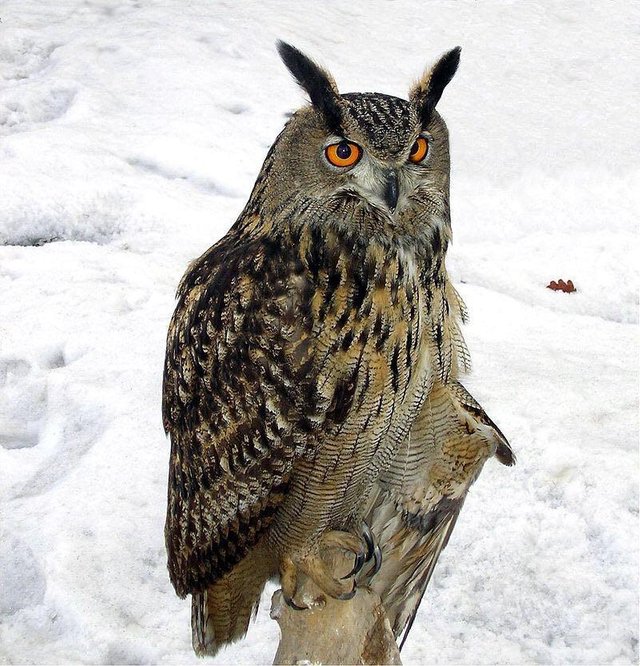The Eurasian Eagle-Owl
The Eurasian eagle-owl (Bubo bubo) is a species of eagle-owl that resides in much of Eurasia. It is also called the European eagle-owl and in Europe, it is occasionally abbreviated to just eagle-owl.[3] It is one of the largest species of owl, and females can grow to a total length of 75 cm (30 in), with a wingspan of 188 cm (6 ft 2 in), males being slightly smaller.[4] This bird has distinctive ear tufts, with upper parts that are mottled with darker blackish colouring and tawny. The wings and tail are barred. The underparts are a variably hued buff, streaked with darker colour. The facial disc is poorly developed and the orange eyes are distinctive.

Besides being one of the largest living species of owl, it is also one of the most widely distributed.[5] The Eurasian eagle-owl is found in many habitats but is mostly a bird of mountain regions, coniferous forests, steppes and other relatively remote places. It is a mostly nocturnal predator, hunting for a range of different prey species, predominantly small mammals but also birds of varying sizes, reptiles, amphibians, fish, large insects and other assorted invertebrates. It typically breeds on cliff ledges, in gullies, among rocks or in other concealed locations. The nest is a scrape in which averages of two eggs are laid at intervals. These hatch at different times. The female incubates the eggs and broods the young, and the male provides food for her and when they hatch, for the nestlings as well. Continuing parental care for the young is provided by both adults for about five months.[6] There are at least a dozen subspecies of Eurasian eagle-owl.[7]
With a total range in Europe and Asia of about 32 million square kilometres (12 million square miles) and a total population estimated to be between 250 thousand and 2.5 million, the IUCN lists the bird's conservation status as being of "least concern".[8] The vast majority of eagle-owls live in mainland Europe, Russia and Central Asia, and an estimated number of between 12 and 40 pairs are thought to reside in the United Kingdom as of 2016, a number which may be on the rise.[9] Tame eagle-owls have occasionally been used in pest control because of their size to deter large birds such as gulls from nesting.[10]
Copy by world of knowledge
Source
Copying/Pasting full or partial texts without adding anything original is frowned upon by the community. Repeated copy/paste posts could be considered spam. Spam is discouraged by the community, and may result in action from the cheetah bot.
More information and tips on sharing content.
If you believe this comment is in error, please contact us in #disputes on Discord
Congratulations! This post has been upvoted from the communal account, @minnowsupport, by sityate from the Minnow Support Project. It's a witness project run by aggroed, ausbitbank, teamsteem, theprophet0, someguy123, neoxian, followbtcnews, and netuoso. The goal is to help Steemit grow by supporting Minnows. Please find us at the Peace, Abundance, and Liberty Network (PALnet) Discord Channel. It's a completely public and open space to all members of the Steemit community who voluntarily choose to be there.
If you would like to delegate to the Minnow Support Project you can do so by clicking on the following links: 50SP, 100SP, 250SP, 500SP, 1000SP, 5000SP.
Be sure to leave at least 50SP undelegated on your account.